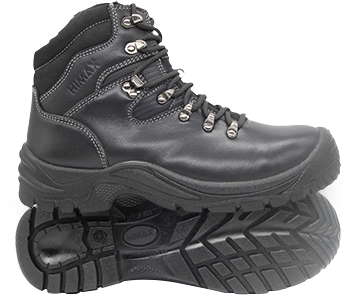ESD OR ANTISTATIC SAFETY SHOES?
Antistatic and ESD safety shoes are both conductive safety shoes. This means they protect electrical equipment by sending (conducting) electrical charges to the ground, preventing a static shock, charge or spark. Conductive safety shoes are worn in industries in which a static shock is problematic or could trigger a fire or explosion and are not the same as isolating safety shoes, like EH-rated safety shoes, which protect you from completing an electrical circuit to the ground.
ANTISTATIC SAFETY SHOES VS. ESD SAFETY SHOES
The applicable standard for safety footwear, EN ISO 20345, specifies a variety of requirements, including for electrostatic properties. It defines three areas, based on contact resistance: conductive, antistatic and electrically insulating footwear. For safety shoes to be labelled S1, they must fulfil the basic requirements plus the additional requirements for antistatic. The same applies to all subsequent safety classifications, for both industrial and occupational shoes. Shoes are antistatic if the measured contact resistance is in the range between 100 kiloohm (105 ohm) and 1 gigaohm (109 ohm). According to the standard, if contact resistance falls below this value, they are considered to be conductive, while a higher value means they are electrically insulating.
ESD and antistatic bring a lot of confusion, and not just when it comes to safety shoes. While one includes the other, it's incorrect to say the same in reverse. Although both terms refer to contact resistance, there are fundamental differences between the two.
- ANTISTATIC safety shoes have a low electrical resistance between 0.1 and 1000 MegaOhm (MΩ). The use of antistatic safety shoes prevents a build-up of static electrical charges in the human body by sending these charges to the ground, preventing a sudden flow of electricity between electrically charged objects caused by contact.
- ESD (or ElectroStatic Discharge) safety shoes on the other hand, have an even lower electrical resistance between 0.1 and 100 (MΩ). The use of ESD safety shoes prevents a build-up of static electrical charges in the human body by sending these charges to the ground in a very safe and controlled manner. They guarantee to prevent the sudden flow of electricity between electrically charged objects caused by contact.

ANTISTATIC
Antistatic safety shoes reduce the chance of electrostatic discharges.

ESD
ESD safety shoes prevent uncontrolled electrostatic discharges.

ESD IN INDUSTRIES
ESD and antistatic safety shoes are used in different type of industries to protect sensitive equipment or components from electrostatic discharges, such as aerospace, industrial equipment manufacturing, semiconductor manufacturing, electrical engineers, telecommunications equipment manufacturing, battery manufacturing, computer equipment manufacturing, medical industry, hospitals and many more.
ESD can prevent a range of harmful effects on worksites. Uncontrolled release of static charges can cause gas, fuel vapour or coal dust explosions, as well as failure of solid state electronics components such as integrated circuits. Therefore it’s crucial that people who work in these environments wear ESD or antistatic safety shoes to protect all electrical components.


ESD CLASSES
Temperature and humidity (or the moisture content in the shoe) have a major effect on the ESD safety shoe’s electrical resistance. Safety shoes with ESD protection are tested and divided into different climate classes, 1, 2 and 3.
The difference between these three classes is the time of conditioning, temperature and humidity. For example, climate class 1 is the ESD class with the highest temperature and lowest humidity. When safety shoes satisfy the class 1 criteria (in other words, an electrical resistance between 0.1 and 100 MΩ), they have a guaranteed low electrical resistance, even under exceptional circumstances.
Testing the ESD properties of safety shoes for ESD certification involves a test method under laboratory conditions. The safety shoe is placed on a stainless steel plate as the first electrode and a counter electrode is placed inside the safety shoe on the insole. Weight of 12.5 kg (+/- 2.5 kg) is then applied. A device measures the contact resistance between the two electrodes. It must be less than 100 megaohm for ESD certification to be granted for the respective climate class.
ESD TECHNOLOGIES













